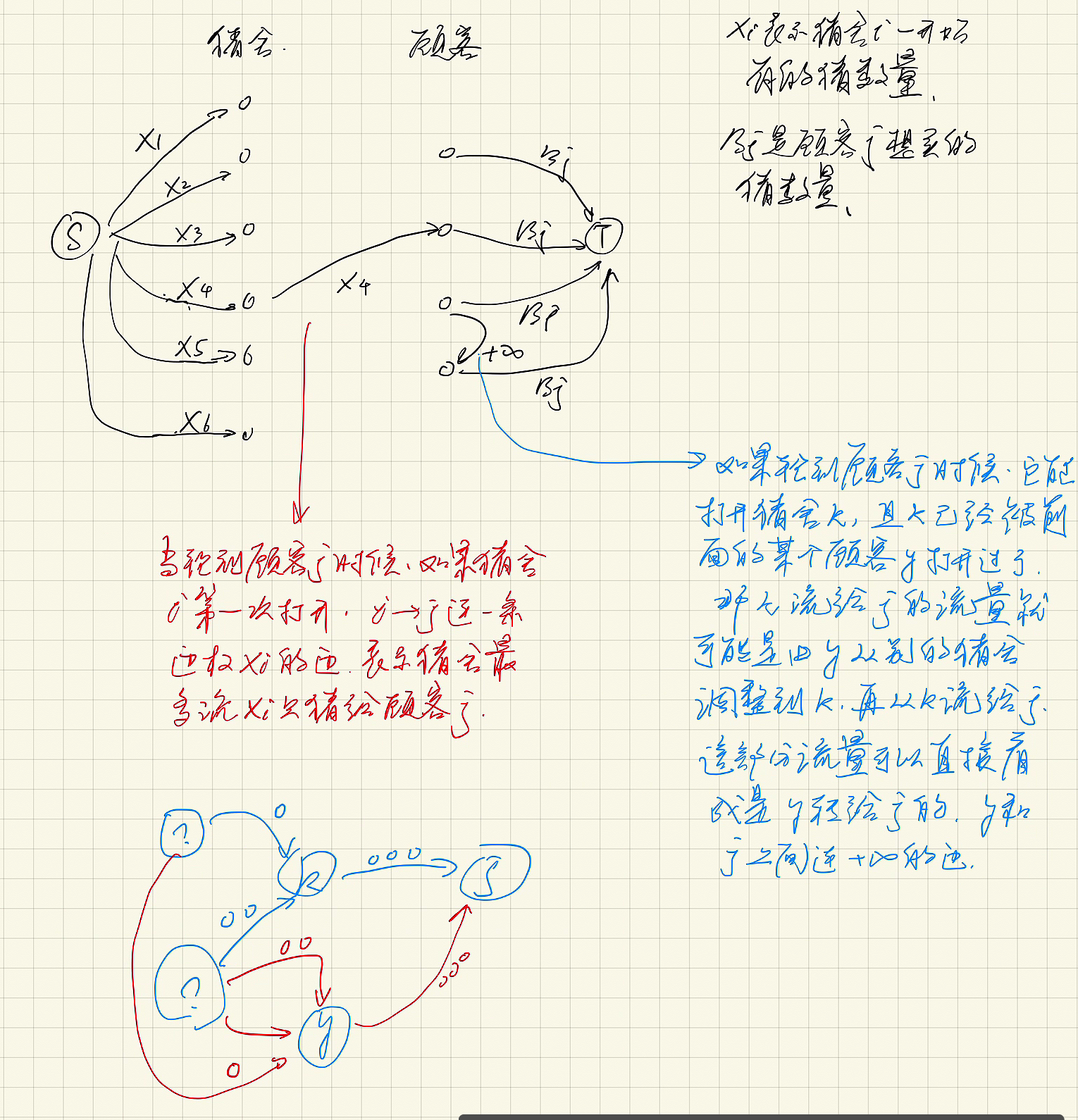
from collections import deque
class FortdFulkerson:
# 输入图中所有边列表[(from1, to1, weight1), (form2, to2, weight2), ......]
# 边可以有重边和自环边
# souece_node 和 end_node 分别为源点和汇点
# 所有节点从1开始连续编号, max_node_num是最大节点数,max_edge_nums是最大边数
def __init__(self, edges, source_node, end_node, max_node_num, max_edge_num):
self.edges = edges[::]
self.source_node = source_node
self.end_node = end_node
self.max_edge_num = max_edge_num
self.max_node_num = max_node_num
# 返回整个图的最大流和每条边的流量以及容量,(max_flow, [(from1, to1, flow1, weight1), (from1, to1, flow1, weight1), ......])
def getMaxFlow(self):
e = [-1] * (self.max_edge_num * 2 + 1) # e[idx]表示编号为idx残量图边的终点, idx//2 就是残量图边对应的原图边的编号
f = [-1] * (self.max_edge_num * 2 + 1) # f[idx]表示编号为idx的残量图边的流量
ne = [-1] * (self.max_edge_num * 2 + 1) # ne[idx]表示根编号为idx的边同一个起点的下一条边的编号
h = [-1] * (self.max_node_num + 1) # h[a]表示节点a为起点的所有边的链表头对应的边的编号
dis = [-1] * (self.max_node_num + 1) # dis[a]表示点a到源点的距离,用于记录分层图信息
cur = [-1] * (self.max_node_num + 1) # cur[a]表示节点a在dfs搜索中第一次开始搜索的边的下标,也称当前弧,用于优化dfs速度
idx = 0
for a, b, w in self.edges:
e[idx], f[idx], ne[idx], h[a] = b, w, h[a], idx
idx += 1
e[idx], f[idx], ne[idx], h[b] = a, 0, h[b], idx
idx += 1
# bfs搜索有没有增广路
def bfs() -> bool:
for i in range(self.max_node_num + 1):
dis[i] = -1
que = deque()
que.append(self.source_node)
dis[self.source_node] = 0
cur[self.source_node] = h[self.source_node]
while len(que) > 0:
cur_node = que.popleft()
idx = h[cur_node]
while idx != -1:
next_node = e[idx]
if dis[next_node] == -1 and f[idx] > 0:
dis[next_node] = dis[cur_node] + 1
cur[next_node] = h[next_node]
if next_node == self.end_node:
return True
que.append(next_node)
idx = ne[idx]
return False
# dfs查找增广路, 返回当前残量图上node节点能流入汇点的不超过limit的最大流量有多事少
def dfs(node, limit) -> int:
if node == self.end_node:
return limit
flow = 0
idx = cur[node] # 从节点的当前弧开始搜索下一个点
while idx != -1 and flow < limit:
# 当前弧优化,记录每一个节点最后走的一条边,只要limit还没有减成0,已经搜过的边的终点
# 能够汇入汇点的流量就已经全部用完了,另外一条路径到同一个点时候没必要重复搜索已经不会
# 再提供流量贡献的邻接点
cur[node] = idx
next_node = e[idx]
if dis[next_node] == dis[node] + 1 and f[idx] > 0:
t = dfs(next_node, min(f[idx], limit - flow))
if t == 0:
# 已经无法提供流量的废点闪删除掉,不再参与搜索
dis[next_node] = -1
# 更新残量图边的流量
f[idx], f[idx ^ 1], flow = f[idx] - t, f[idx ^ 1] + t, flow + t
idx = ne[idx]
return flow
max_flow = 0
while bfs():
# 只要还有增广路,就dfs把增广路都找到,把增广路上的流量加到可行流上
max_flow += dfs(self.source_node, 0x7fffffff)
return max_flow
m, n = map(int, input().split())
X = list(map(int, input().split()))
S, T = n+1, n+2
edges = []
visit = [[] for i in range(m)] # visit[idx]记录idx号猪舍被那些顾客打开过
for i in range(1, n+1):
arr = list(map(int, input().split()))
buy_cnt = arr[-1]
for house_idx in arr[1:-1]:
house_idx -= 1
if len(visit[house_idx]) == 0:
edges.append((S, i, X[house_idx]))
else:
for cus_idx in visit[house_idx]:
edges.append((cus_idx, i, 0x7fffffff))
visit[house_idx].append(i)
edges.append((i, T, buy_cnt))
print(FortdFulkerson(edges, S, T, n+2, len(edges)).getMaxFlow())

